
Leader- and Team-Member Exchanges and Their Relationships with Organizational and Interpersonal Counterproductive Work Behaviors: Moderation by Envy and Group Size in Israel and USA
[Los intercambios entre lĂder y subordinado y entre el equipo y sus miembros y sus relaciones con los comportamientos laborales organizativos e interpersonales contraproductivos: el efecto moderador de la envidia y del tamaño del grupo en Israel y en EE.UU.]
Or Shkoler1, Edna Rabenu2, Filiz Tabak3, and Mariana J. Lebron3
1Independent Researcher, Israel; 2Netanya Academic College, Israel; 3Towson University, Maryland, USA
https://doi.org/10.5093/jwop2019a19
Received 8 February 2019, Accepted 29 March 2019
Abstract
The present research investigated the effects of social exchanges of employees with their immediate manager (i.e., Leader-Member eXchange; LMX) and with their direct working unit/team (i.e., Team-Member eXchange; TMX) on counterproductive work behaviors (CWBs), both – towards the organization or towards colleagues. The research also explored the moderating effects of dispositional envy and the size of the working team on said associations. Data from 221 Israeli employees (Study 1) and 186 American workers (Study 2) were collected. The majority of our hypotheses were supported, with findings indicating interesting cultural differences. Implications and future research suggestions are discussed.
Resumen
Este estudio investiga los efectos de los intercambios sociales de los empleados con su supervisor directo (es decir, el intercambio entre líder y subordinado, LMX) y con su unidad/equipo de trabajo directo (es decir, intercambio entre el equipo y un miembro de este, TMX) en los comportamientos laborales contraproductivos, tanto en relación con la organización como con sus compañeros. La investigación también ha explorado el efecto moderador de la envidia disposicional y del tamaño del equipo en dichas asociaciones. Se recogieron datos de 221 empleados israelíes (estudio 1) y de 186 trabajadores estadounidenses (estudio 2). La mayor parte de nuestras hipótesis fueron confirmadas, descubriéndose diferencias culturales interesantes. Se discuten sus implicaciones y las propuestas de investigación futuras
Palabras clave
Intercambio lĂder-miembro, Intercambio equipo-miembro, Comportamientos laborales contraproductivos, Envidia, Tamaño del grupo, Diferencias culturales.Keywords
Leader-member exchange, Team-member exchange, Counterproductive work behaviors, Envy, Group size, Cultural differences.Cite this article as: Shkoler, O. , Rabenu, E. , Tabak, F. , & Lebron, M. J. (2019). Leader- and Team-Member Exchanges and Their Relationships with Organizational and Interpersonal Counterproductive Work Behaviors: Moderation by Envy and Group Size in Israel and USA. Journal of Work and Organizational Psychology, 35, 145 - 156. https://doi.org/10.5093/jwop2019a19
Correspondence: or.shkoler@gmail.com (O. Shkoler).“A key paradigm in examining workplace relations is social exchange theory (SET). Its basic premise is that human relations are formed based on subjective cost-benefit analysis... SET claims that social relationships are based on the trust that gestures of goodwill will be reciprocated (Blau, 1964)” (Chernyak-Hai & Rabenu, 2018, p. 458). On the contrary, gestures of ill-will might be reciprocated accordingly as well (e.g., Martin, Guillaume, Thomas, Lee, & Epitropaki, 2016; Shkoler & Tziner, 2017). Moreover, the negative components of performance (e.g., Counterproductive Work Behaviors; CWBs) may have an even greater importance on employees’ performance appraisal than the positive components (e.g., Organizational Citizenship Behaviors; OCBs) (e.g., Rotundo & Sackett, 2002). In addition, CWB has also shown to have important economical, sociological, and psychological implications (e.g., Aubé, Rousseau, Mama, & Morin, 2009; Bodankin & Tziner, 2009). The current paper contributes to the accumulated SET literature as it focuses on the proximal exchanges between: (1) employees and their managers (i.e., Leader-Member Exchange, LMX), (2) employees and their team members (i.e., Team-Member Exchange, TMX), and their effect on workplace misbehavior (or CWBs). We chose to investigate the association between LMX and CWB because further contribution and elaboration are needed about this link, as Jawahar, Schreurs, and Mohammed (2018) stated: “... we have very little insight about the theoretical mechanism explaining the leader-member exchange-counterproductive work behavior (LMX–CWB) relationship” (p. 557). Additionally, the literature produced inconsistent results regarding the relationship between LMX and CWB; some found significant negative associations (e.g., El Akremi, Vandenberghe, & Camerman, 2010; González-Navarro, Zurriaga-Llorens, Tosin Olateju, & Llinares-Insa, 2018) and some found no significant correlations between them (e.g., Jawahar et al., 2018). This has led us to think about the existence of indirect effects in said relationships, such as potential moderators. Hence, based on the long discussion regarding the effects of contextual vs. individual differences in the work context (see Judge & Zapata, 2015; Staw & Cohen-Charash, 2005), we will test the effects of team size (i.e., contextual) and dispositional envy (i.e., individual differences) as the possible moderators (see Figure 1). This is because envy (as a disposition) may affect an individuals’ perception of a social exchange, while the size of the team is an influential contextual parameter that also may impact the social exchanges, irrespective of the person themselves (see Dispositional Envy and Team Size sections below). In the same vein, negative exchanges at the workplace may occur not just in a person-supervisor/manager manner, but also the person-team environment. However, to the best of our knowledge, studies on the link between TMX and CWB are scarce (an example for a research scrutinizing them is Jian & Ting, 2014). Thus, as the contemporary workplace is often comprised of teams (Daft, 2015), in different sizes, it is highly relevant and important to study the relationship between TMX and CWB in this context. We have conducted the research in two follow-up studies (in different national cultures). Leader-Member eXchange (LMX) The dyadic-focused LMX theory, as one of the fundamental components in the social network at the workplace (Cole, Schaninger, & Harris, 2002), illustrates that managers tend to develop different relationship/management styles with each of their subordinates (Graen & Uhl-Bien, 1995; see also Waismel-Manor, Tziner, Berger, & Dikstein, 2010). This may drive the employees to behave differently (e.g., Gerstner & Day, 1997; Ilies, Nahrgang, & Morgeson, 2007). Based on social exchange and reciprocity rationales (Blau, 1964; Gouldner, 1960), employees in good relationships with their manager (i.e., high LMX) would feel obliged to mutually reciprocate these relations (see also Adams, 1965). As such, high quality LMX results in high levels of trust, respect, and commitment. Employees with good relations with the manager are likely to receive more rewards (formal and informal), resources, support (emotional as well), feedback, and even career opportunities (Clarke & Mahadi, 2017; Graen & Uhl-Bien, 1995). This leads them to engage in more positive behaviors (Breevaart, Bakker, Demerouti, & van den Heuvel, 2015; Waismel-Manor et al., 2010; for a meta-analysis, see Rockstuhl, Dulebohn, Ang, & Shore, 2012). It is important to note that poor relations (i.e., low LMX) with a manager will also result in reciprocal ‘poor or bad’ behavior, such as counterproductive work behaviors (e.g., Chernyak-Hai & Tziner, 2014). This highlights the important role of managers in influencing employees’ attitudes, cognitions, and behaviors. Team-Member eXchange (TMX) While the LMX approach focuses on the dyadic relationship between a manager and the employee (Dansereau, Graen, & Haga, 1975), it is also important to gauge the quality of proximal relations with team-members, as many organizations in the modern working world operate in groups and teams and not (just) as individuals (Daft, 2015). Examples are the army, high-tech or startup companies. The similar, yet less-known (Murphy, Wayne, Liden, & Erdogan, 2003), Team-Member eXchange Theory (TMX; Seers, 1989) revolves around the quality of relationships between a worker and his or her work group/team/unit, not the manager. TMX argues that high quality relations manifest also in the willingness of an employee (as a group-member) to help other group-members, share ideas and information freely, and provide them with feedback (Hu, Ou, Chiou, & Lin, 2012; Seers, 1989). This social exchange is also based on mutual reciprocity and, to the extent the group is willing to do the same for the worker (Seers, 1989), ultimately influencing the effectiveness and cohesion of the group (Abu Bakar & Sheer, 2013). For further reading on TMX, see Chen (2018). So, LMX and TMX are social exchange-based variables which capitalize on the transactional mindset and reciprocity (Blau, 1964; Gouldner 1960) as previously mentioned. Good exchanges may lead to good results, just as ill exchanges might end in accordingly ill manners (which are a part of a bigger construct called counterproductive work behaviors). Counterproductive Work Behaviors (CWBs) CWB is defined as “any intentional behavior on the part of an organizational member viewed by the organization as contrary to its legitimate interests” (Sackett & DeVore, 2001, p. 145; see also Cohen-Charash & Mueller, 2007; Ho, 2012). CWBs (e.g., Chernyak-Hai & Rabenu, 2018; Chernyak-Hai & Tziner, 2014; Cohen-Charash & Mueller, 2007; Ho, 2012) or sometimes addressed as ‘workplace misbehaviors’ (e.g., Berry, Ones, & Sackett, 2007; Cohen-Charash & Mueller, 2007; Dilchert, Ones, Davis, & Rostow, 2007; Shkoler & Tziner, 2017), “deviant behaviors” (e.g., Levy & Tziner, 2011; Zhang, Mayer, & Hwang, 2018) or counterproductive performance (e.g., Jawahar et al., 2018; Rotundo & Sackett, 2002) have received increasing attention from both the academic and the organizational fronts. This is due to their important economical, sociological, and psychological implications (Aubé et al., 2009; Levy & Tziner, 2011). CWBs usually violate important organizational norms and harm organizations in many ways, for example, the goals, employees, procedures, productivity, and profitability (Aubé et al., 2009; Dalal, 2005; Lanyon & Goodstein, 2004; Pearson, Andersson, & Porath, 2005; Robinson, 2008; Spector et al., 2006; Vardi & Weitz, 2016). Typically, such volitional behaviors are categorized into two main groups: (1) CWB-O (organizational CWB), such as theft, sabotage, withdrawal, pretending to be sick, and (2) CWB-I (interpersonal-CWB; Bennett & Robinson, 2000, 2003; Berry et al., 2007), such as speaking ill of other workers, harassment, insulting and/or ignoring others at work (see Bennett & Robinson, 2000; Gruys & Sackett, 2003; Robinson & Bennett, 1995; Spector, Bauer, & Fox, 2010; Spector et al., 2006). As can be seen, these behaviors are directed towards the organization itself or its members (employees and management alike), and thus, are generally costly to both individuals and organizations (Bennett & Robinson, 2003). There are many antecedents to CWBs, like (a) individual differences (e.g., Berry et al., 2007; Dalal, 2005; Dilchert et al., 2007; Salgado, 2002), such as cognitive abilities, emotional stability, openness to experience, agreeableness, and conscientiousness, (b) job experiences (e.g., Hollinger & Clark, 1982; Kulas, McInnerney, DeMuth, & Jadwinski, 2007; Shkoler & Tziner, 2017), such as organizational justice perceptions, and job satisfaction, and (c) work stressors (e.g., Bruk-Lee & Spector, 2006; Chen & Spector, 1992; Diefendorff & Mehta, 2007; Mitchell & Ambrose, 2007; Zhang, et al, 2018), such as abusive/bullying supervision, restrictive rules and procedures, and lack of resources. For example, dissatisfied employees are more likely to engage in theft (Kulas et al., 2007), and abusive supervision might increase employees’ propensity to engage in negative behavior intended not only to harm the abuser directly, but also to damage the organization itself (Chen & Spector, 1992; Mitchell & Ambrose, 2007). Leader- and Team-Member eXchanges and Counterproductive Work Behaviors LMX and TMX are both under the same theoretical framework of the Social Exchange Theory (e.g., Chernyak-Hai & Rabenu, 2018; Colquitt et al., 2013). Social exchanges tend to be reciprocal (e.g., Gouldner, 1960), such that good-quality exchange of an employee with his/her direct manager or the immediate work team may promote knowledge sharing, mutual trust, help, and other organizational citizenship behaviors (e.g., Ilies et al., 2007; Podsakoff, Whiting, Podsakoff, & Blume, 2009). On the contrary, low-quality exchange may lead to negative outcomes, such as counterproductive work behaviors (e.g., Chernyak-Hai & Tziner, 2014; Jian & Ting, 2014; Shu & Lazatkhan, 2017; Zhenglong, Dong, & Hongdan, 2011). Specifically, there were very few papers dealing with the relationship between LMX and TMX with CWB-O and CWB-I (respectively), and they were also exclusively conducted in China. Zhenglong et al. (2011) have found that LMX was negatively associated with both CWB-O and CWB-I, but had a stronger association with the former. In addition to that, Jian and Ting (2014) have found that LMX is negatively correlated with CWB-O, while TMX is negatively linked to CWB-I. In light of the scarce literature regarding the linkages between said variables, and external validity issues (e.g., a focus on the Chinese culture), we hypothesize negative associations between the exchange variables (i.e., LMX/TMX) and CWB. In order to broaden our understanding of the phenomena under investigation, we will test this assumption against both CWB groups (i.e., CWB-O/CWB-I). Thus, we hypothesize that:
Faced with inconsistent literature about the relationship between LMX and CWB (see Introduction section), it is plausible that other indirect forces regulate it (e.g., Shkoler, Rabenu, & Tziner, 2017). In the same vein, we would assume this is relevant for TMX as well, as they are both exchange-based variables, only with a different referent. For the purpose of the study, we have investigated the moderating effects of dispositional envy and team size. Individual Difference Buffering Effect - Dispositional Envy Envy is a complex emotion compiled of the subjective feelings aroused when one person desires something that someone else has/possesses (Smith, Parrott, Diener, Hoyle, & Kim, 1999), which has to be central to the envious part’s self-concept (Lazarus, 1991). These feelings may revolve around ill will, anger, self-criticism, dissatisfaction, hatred, or even felt inferiority (e.g., Johnson-Laird & Oatley, 1989; Luglio, 2002; Smith, Kim, & Parrott, 1988; Smith, Parrott, Ozer, & Moniz, 1994). Envy is considered to occur when two individuals are mutually comparable (see Schoeck, 1969) in a unit relationship (Heider, 1958). Since “the literature has traditionally focused on dispositional envy...” (González-Navarro et al., 2018, p. 1459) we focus on this aspect of envy, as well. Envy-prone (i.e., dispositional envy) people are more likely to be susceptible to frustration, subjective sense of injustice (Smith et al., 1999; Smith et al., 1994), and experience less happiness, life satisfaction (Milfont & Gouveia, 2009), self-esteem (Zeelenberg & Pieters, 2007), but more grief (Barr & Cacciatore, 2007) and shame (Zeelenberg & Pieters, 2007). They also are more likely to engage in CWB-I behaviors (Cohen-Charash & Mueller, 2007), become more hostile, anxious, and tend to create a negative workplace environment (Cohen-Charash, 2009). Still, “the assessment of the social nature of envy has been underestimated, and little is known about its relationships with other social variables (e.g., LMX and ownership)” (González-Navarro et al., 2018, p. 1459). As stated before, low-quality exchanges (i.e., LMX and TMX) might lead to negative outcomes, such as CWBs (e.g., Chernyak-Hai & Tziner, 2014; Jian & Ting, 2014; Shu & Lazatkhan, 2017; Zhenglong et al., 2011). Moreover, we may assume that individuals with different levels of dispositional envy would react differently to perceived unfair/unequal exchanges in the work context. We hypothesize this dispositional tendency would enhance the negative effects that LMX and TMX may have on CWB-O and CWB-I, respectively. To elaborate, we have mentioned before that deteriorating relationships with the immediate manager and/or unit members would result in increased workplace misbehavior (i.e., H1.1-H2.2). When employees have higher envy tendencies, this might lead them to feel increased subjective injustice and inferiority in their social exchanges. As such, they are, by definition, more judgmental than individuals with lower envy tendencies to these exchanges. For example, employees with higher envy dispositions might perceive lower-quality exchanges between team members (i.e., TMX, such as less information sharing, less backing up for other members) even more profoundly and negatively than what these exchanges would have been perceived by workers with lower envy dispositions. Since an envious person is driven to act for assuaging these unpleasant feelings of subjectively felt injustice and inferiority (Heider, 1958), he/she would feel compelled to “equalize positions” (Cohen-Charash & Mueller, 2007, p. 666) by harming others (i.e., CWB-I) and/or the organization itself (i.e., CWB-O), as a representative of its members. Thus, we hypothesize that:
Environmental Buffering Effect – Work Group/Team Size “... team size can be viewed not only as a catalyst of team dynamics but also as a context that moderates behavioral or social phenomena (Kozlowski & Bell, 2003)”, but at the same time “the role of team size as a contextual moderator has received only limited attention in the literature” (Cha, Kim, Lee, & Bchrach, 2015). The size of the team or group (i.e., work unit) has been modeled as a predictor (e.g., Curral, Forrester, Dawson, & West, 2001; Haleblian & Finkelstein, 1993; Thompson et al., 2015), and only very recently as a moderator (e.g., Cha, Kim, Lee, & Bachrach, 2015). However, it was mostly modeled as a control variable (e.g., Ferguson & Barry, 2011; Jackson et al., 1991; Wiersema & Bantel, 1992). In addition, group size has been related to task interdependence (Ferguson & Barry, 2011), team climate, and support for innovation (Curral et al., 2001), and even team diversity (Cha et al., 2011). It is important to demonstrate the impact the size of the work group may have on its effectiveness, interpersonal relations, and members’ behaviors. In teams, the size is a built-in requirement for the group’s effectivity and interpersonal relationships between its members (Katzenbach, & Smith, 2015). Such small working groups may facilitate frequent and fluent communication between members and may enable them to better understand each other’s roles and skills (Katzenbach & Smith, 2015). This is emulated by the definition of a work team: “A team is a small number of people with complementary skills who are committed to a common purpose, performance goals, and approach for which they hold themselves mutually accountable” (Katzenbach & Smith, 2015, p. 41). In contrast, larger groups have coordination and communication problems (e.g., Blau, 1970; Shaw & Harkey, 1976) and might be a hindrance at the feet of organizational performance and effectivity. In addition, we draw upon the psycho-social theories of “herding mentality” (Braha, 2012; Toch, 1988) and “diffusion of responsibility” (Kassin, Fein, Markus, & Burke, 2013). As the group size increases, there is a reduction in the sense of responsibility of the individual and the impression of universality of groups’ behavior (Greenberg, 2010; Toch, 1988). By acting/moving “with the group” a group member reduces the danger to oneself (Hamilton, 1971). In human behavior, this goes from demonstrations to riots and general strikes (Braha, 2012). Thus, we can see that a larger unit may have a negative impact on the work context. The larger work group size would mitigate, or even overwhelm, the effects good relationships with the immediate manager and/or unit members may have on workplace misbehavior. Thus, we hypothesize that:
Method Figure 1 below summarizes the study’s hypotheses in a path diagram. Figure 1 Overall Research Model  Participants. Participants were 221 Israeli employees of various organizations and industries (e.g., services, high-tech, manufacturing), of which 47% were male and 53% female between the ages of 19-62 years (M = 29.86, SD = 9.25). In terms of education, 48% were B.A. students, 2% had some college education, 43% held a B.A/B.S. degree, and 7% held a M.A. degree or above. Regarding their work, 62% were in non-managerial roles, while 38% worked as managers. Tenure ranged between 0.1 and 32 years (M = 5.94, SD = 7.52). Measures LMX was gauged by the Multi-Dimensional Measure of Leader-Member eXchange (LMX-MDM; Liden & Maslyn, 1998) consisting of 12 Likert-type items ranging from 1 (strongly disagree) to 7 (strongly agree). Original reliability was a = .79, on average. TMX was gauged by a scale based on Seers (1989; see also Liden, Wayne, & Sparrowe, 2000) consisting of 9 Likert-type items ranging from 1 (strongly disagree) to 7 (strongly agree). Original reliability was a = .88. Dispositional envy was gauged by the Dispositional Envy Scale (DES; Smith et al., 1999) consisting of 7 Likert-type items ranging from 1 (strongly disagree) to 7 (strongly agree). Original reliability was a = .89. CWBs were gauged by the Counterproductive Work Behavior Checklist (CWB-C; Spector et al., 2006; see also Spector et al., 2010) consisting of 10 Likert-type items ranging from 1 (never) to 7 (everyday). The scale was divided into 5 items for measuring CWB-O (a = .84), and 5 for CWB-I (a = .85). Group size was gauged by a single demographical item: “The working group in which you work/belong has _______ employees.” Reliability coefficients (Cronbach’s a), means and standard deviations of the variables are presented in Table 1 (Results section). Table 1 Pearson Correlation Matrix, Means and Standard Deviations for the Israeli Sample (N = 221), with Reliability Coefficients on the Diagonal  Note. LMX = Leader-Member Exchange; TMX = Team-Member Exchange; Envy = Dispositional Envy; CWB-O = Organizational Counterproductive Work Behaviors; CWB-I = Interpersonal Counterproductive Work Behaviors. 1Range of team size between 1 and 150 employees. Procedure. The electronic version of the research questionnaire was emailed as a link to employees in various organizations in Israel. Those wishing to participate replied that they filled the questionnaire and were included in the total sample. Data analyses were done utilizing SPSS software (v. 23). Common-method bias (CMB). In order to assess the extent to which inter-correlations among the variables might be an artifact of common method variance (CMV) we employed the Harman’s single-factor model (in which all items loaded on one factor) and a latent common method factor model (in which all items loaded on both their expected factors and one latent common method factor) as suggested by Podsakoff, MacKenzie, Lee, and Podsakoff (2003). The Harman’s single-factor method accounted only for 23.60% of the explained variance: c2(342) = 1,117.69, p = .000, c2/df = 3.27, CFI = .71, NFI = .87, GFI = .90, SRMR = .11, RMSEA (90% CI) = .17 (.09-.21), p-close = .003. In addition, the latent common method factor analysis produced for 21.94% of the explained variance: c2(337) = 975.45, p = .000, c2/df = 2.89, CFI = .82, NFI = .89, GFI = .92, SRMR = .09, RMSEA (90% CI) = .10 (.02-.16), p-close = .017. While these result does not rule out completely the possibility of same-source bias (i.e., CMV), according to Podsakoff et al. (2003) less than 50% (R2 < .50) of the explained variance accounted for by the first emerging factor indicates that CMB is an unlikely explanation of our investigation’s findings, in conjunction with the bad model fit for each analysis. Results Bivariate zero-order correlation matrix among the variables of the research is displayed in Table 1. Table 1 shows that (1) LMX negatively correlates with CWB-O, but (2) positively with CWB-I, (3) TMX has no significant association with CWB-O, nor (4) with CWB-I. This shows little support for our basic hypotheses. Further, in order to test the moderation hypotheses (H3.1-H6.2) we employed hierarchical regression analyses. The findings are presented in Table 2, for envy and group size as moderators, respectively. It is important to note that while our basic bivariate hypotheses were not supported, for the most part, it is safe and statistically sound to test for moderation even in the absence of a statistically significant correlation between the predictor and the criterion (see Appendix A in Shkoler et al., 2017). Table 2 Hierarchical Regression Coefficients in Predicting CWB-O and CWB-I, Israeli Sample (N = 221) 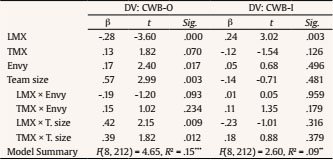 Note. DV = dependent variable; LMX = Leader-Member Exchange; TMX = Team-Member Exchange; Envy = Dispositional Envy; CWB-O = Organizational Counterproductive Work Behaviors; CWB-I = Interpersonal Counterproductive Work Behaviors. *p < .05, **p < .01, ***p < .001. As can be seen in Table 2, none of the interaction effects were significant, and thus, envy does not moderate the relationships between LMX or TMX and CWB-O or CWB-I. Hence, H3.1-H4.2 were not supported. In addition, as can be seen in Table 2, half of the interaction effects were significant, and thus group size does not moderate the relationships between LMX or TMX and CWB-I (H5.2 and H6.2, respectively). However, group size enhances the effect LMX or TMX have on CWB-O (H5.1 and H6.1, respectively). Figures 2 and 3 display the interaction effects graphically. Figure 2 Interaction Effect (LMX × Team Size) on CWB-O, Israeli Sample. 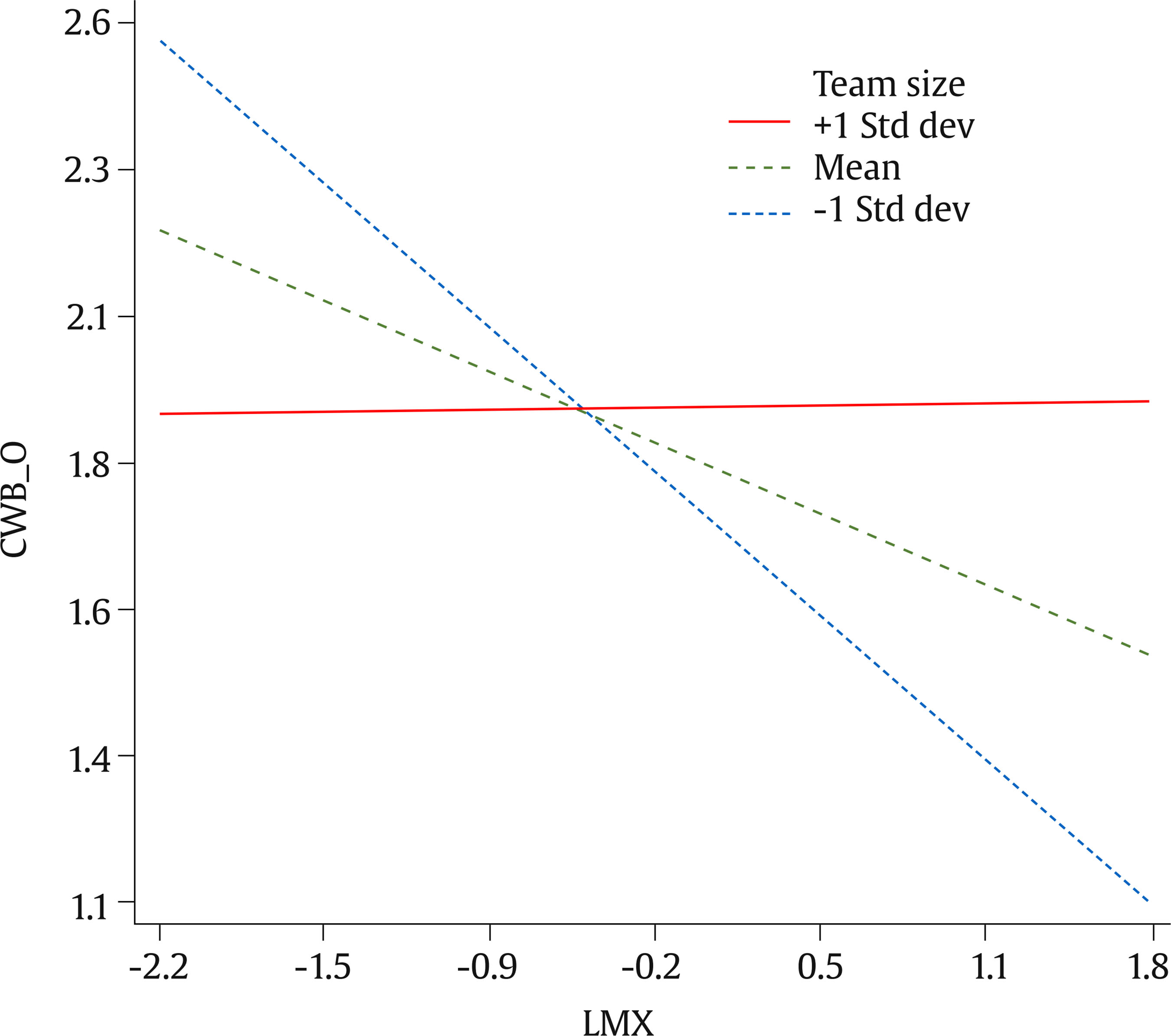 Figure 3 Interaction Effect (TMX × Team Size) on CWB-O, Israeli Sample. 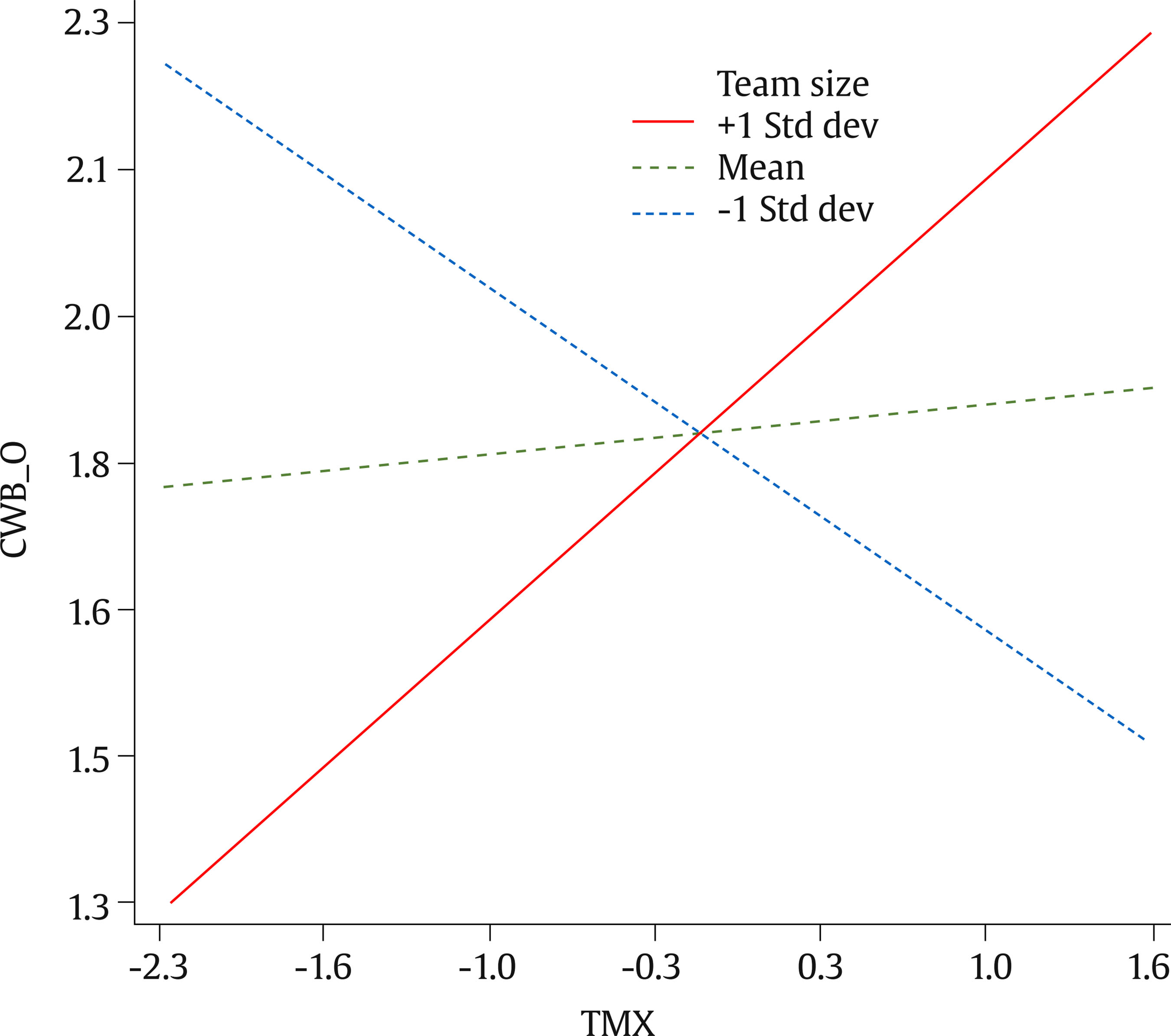 Figure 2 shows that as the group size increases, the negative effect that LMX has on CWB-O diminishes (i.e., positively enhanced). Figure 3 shows that as the group size increases, the non-significant effect between TMX and CWB-O is negative in small sized groups (i.e., -1 SD from the mean) but becomes positive in larger teams (i.e., +1 SD from the mean). Discussion In this study, we investigated the relationships between LMX and TMX to CWB-O and CWB-I, moderated by team size and envy. While TMX had no effect on either CWB-O or CWB-I, LMX had a negative effect on CWB-O, as hypothesized, but positive one on CWB-I, meaning that good relations with the direct manager decreased the probability of engaging in CWB-O but increased it for CWB-I. Perhaps, when one has a good relationship with the immediate manager, the CWB-O decreases since the manager is perceived as representing the organization. However, there can still be “volitional” interpersonal behaviors to other team members or colleagues (e.g., malicious gossip, swearing, verbally attacking, and making fun of someone). This counterintuitive association between LMX and CWB-I may be explained by the perceived advantage an employee with good LMX relations might have over other workers (e.g., “the manager has my back”). This sense of support might endorse more unfiltered behavior towards others (for example, an individual may feel “safer” to speak ill of someone when he/she has good relations with the direct manager, as opposed to a situation whereas these relations are bad). In light of this postulated explanation, and the modest results derived from our study, we assume that our social-exchange-focused model may be affected by the culture in which the study was conducted (i.e., Israel). For example, as for the cultural dimension of power distance (the extent to which the less powerful members of institutions and organizations within a country expect and accept that power is distributed unequally; Hofstede, 2017) “Israel is at the very low end of this dimension compared to other countries... Workplaces have an informal atmosphere with direct and involving communication and on a first name basis. Employees expect to be consulted” (Hofstede, 2017). Moreover, regarding the cultural dimension of individualism-collectivism (the degree of interdependence a society maintains among its members; Hofstede, 2017), in Israel the “communication is direct and expressive”. Therefore, it is plausible that in the Israeli culture the effects of exchanges between leader- and team-members on interpersonal-CWB are not moderated by group size. This is due to the communication being vastly informal to begin with, encouraging less formal exchanges (this is, of course, may be true to a certain extent of the size of the group). These cultural differences may also be relevant for the findings showing that envy had no significant moderation effects in the Israeli case (will be discussed in the General Discussion section). As such, we searched for cultures that greatly differ from Israel on said dimensions, in which we would conduct a subsequent study. To that end, collaboration was found in the USA, which, as opposed to Israel, is characterized by considerably higher individualism and power distance (see: Hofstede, 2017). We believed that such vast differences may result in different findings we already derived from Study 1. We chose a cross-cultural (i.e., inter-country), and not regional (i.e., intra-country), comparing approach because we advocate the notion Smith (2002) has portrayed: Focusing on the culture-level enables researchers to characterize the broader environmental and social context within which individuals are socialized. A map of the world that is constructed not on the basis of geography, but on the basis of aggregated psychological data affords an opportunity to predict the types of socialization practices to be expected at particular locations. This should help to better understand why particular psychological phenomena prevail in some regions and not in others (p. 4). This also supports the contention of eminent scholars that the ultimate test for validity of findings is their recurrence in numerous replications (James, Mulaik, & Brett, 1982). In light of the partial support our model has received in Study 1, we thought it is possible that the modest results were influenced by the culture in which the study was conducted. Moreover, social exchanges may vary from one culture to another, and since LMX and TMX are exchange-based variables, their perception and outcomes may be culturally-dependent. As such, we searched for cultures that greatly differ from Israel on said dimensions, in which we could conduct a consequent study. To that end, collaboration was found in the USA, which, as opposed to Israel, is characterized by considerably higher individualism and low power distance (see Hofstede, 2017). We believed that such vast differences may result in different findings we already found in Study 1. We chose a cross-cultural (i.e., inter-country), and not regional (i.e., intra-country), comparative approach because we advocate the notion Smith (2002) has portrayed: Focusing on the culture-level enables researchers to characterize the broader environmental and social context within which individuals are socialized. A map of the world that is constructed not on the basis of geography, but on the basis of aggregated psychological data affords an opportunity to predict the types of socialization practices to be expected at particular locations. This should help to better understand why particular psychological phenomena prevail in some regions and not in others (p. 4). This also supports the contention of eminent scholars that the ultimate test for validity of findings is their recurrence in numerous replications (James et al., 1982). Method Participants. Participants were 186 employees participating in Study 1 from various U.S. organizations and industries (e.g., services, high-tech, manufacturing), of which 43% were male and 57% were females between the ages of 20 and72 years (M = 29.03, SD = 10.49). In terms of education, 2% had full high-school education, 35% were B.S/B.A. students, 12% had some college education, 13% held a B.S/B.A. degree, and 38% held a M.A. degree or above. Regarding their work, 52% were in non-managerial roles, while 48% worked as managers. Tenure ranged between 0-33 years (M = 4.22, SD = 5.16). Measures. The exact same measures used in Study 1 were also used in Study 2. Reliability coefficients (Cronbach’s a), means and standard deviations of the variables are presented in Table 3 (Results section). Table 3 Pearson Correlation Matrix, Means and Standard Deviations for the USA Sample (N = 186), with Reliability Coefficients on the Diagonal  Note. LMX = Leader-Member Exchange; TMX = Team-Member Exchange; Envy = Dispositional Envy; CWB-O = Organizational Counterproductive Work Behaviors; CWB-I = Interpersonal Counterproductive Work Behaviors; 1Range of team size between 1 and 115 employees. *p < .05, **p < .01, ***p < .001. Procedure. The electronic version of the research questionnaire was emailed as a link to employees in various organizations in Israel. Those wishing to participate replied that they did and were included in the total sample. Data analyses were done utilizing SPSS software (v. 23). Common-method bias (CMB). In order to assess the extent to which inter-correlations among the variables might be an artifact of common method variance (CMV), we employed the Harman’s single-factor model (in which all items loaded on one factor), and a latent common method factor model (in which all items loaded on both their expected factors and one latent common method factor) as suggested by Podsakoff et al., 2003. The Harman’s single-factor method accounted only for 30.78% of the explained variance: c2(342) = 1,573.22, p = .000, c2/df = 4.60, CFI = .75, NFI = .82, GFI = .88, SRMR = .14, RMSEA (90% CI) = .22 (.11-.30), p-close = .000. In addition, the latent common method factor analysis produced for 28.11% of the explained variance: c2(337) = 1,294.73, p = .000, c2/df = 3.84, CFI = .80, NFI = .85, GFI = .91, SRMR = .10, RMSEA (90% CI) = .13 (.04-.17), p-close = .009. While these result does not rule out completely the possibility of same-source bias (i.e., CMV), according to Podsakoff et al. (2003) less than 50% (R2 < .50) of the explained variance accounted for by the first emerging factor indicates that CMB is an unlikely explanation of our investigation’s findings, in conjunction with the bad model fit for each analysis. Results Bivariate zero-order correlation matrix is among the variables of the research is displayed in Table 3. Table 3 shows that (1) LMX negatively correlates with CWB-O and (2) negatively with CWB-I, (3) TMX also negatively associates with CWB-O and (4) with CWB-I. This shows full support for our basic hypotheses. Further, in order to test the moderation hypotheses (H3.1-H6.2), we employed hierarchical regression analyses. The findings are presented in Table 4, for envy and group size as moderators, respectively. Table 4 Hierarchical Regression Coefficients in Predicting CWB-O and CWB-I, USA Sample (N = 186) 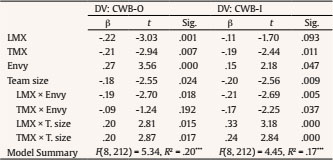 Note. DV = dependent variable; LMX = Leader-Member Exchange; TMX = Team-Member Exchange; Envy = Dispositional Envy; CWB-O = Organizational Counterproductive Work Behaviors; CWB-I = Interpersonal Counterproductive Work Behaviors. *p < .05, **p < .01, ***p < .001. Figure 4 Interaction Effect (LMX × Envy) on CWB-O, USA Sample. 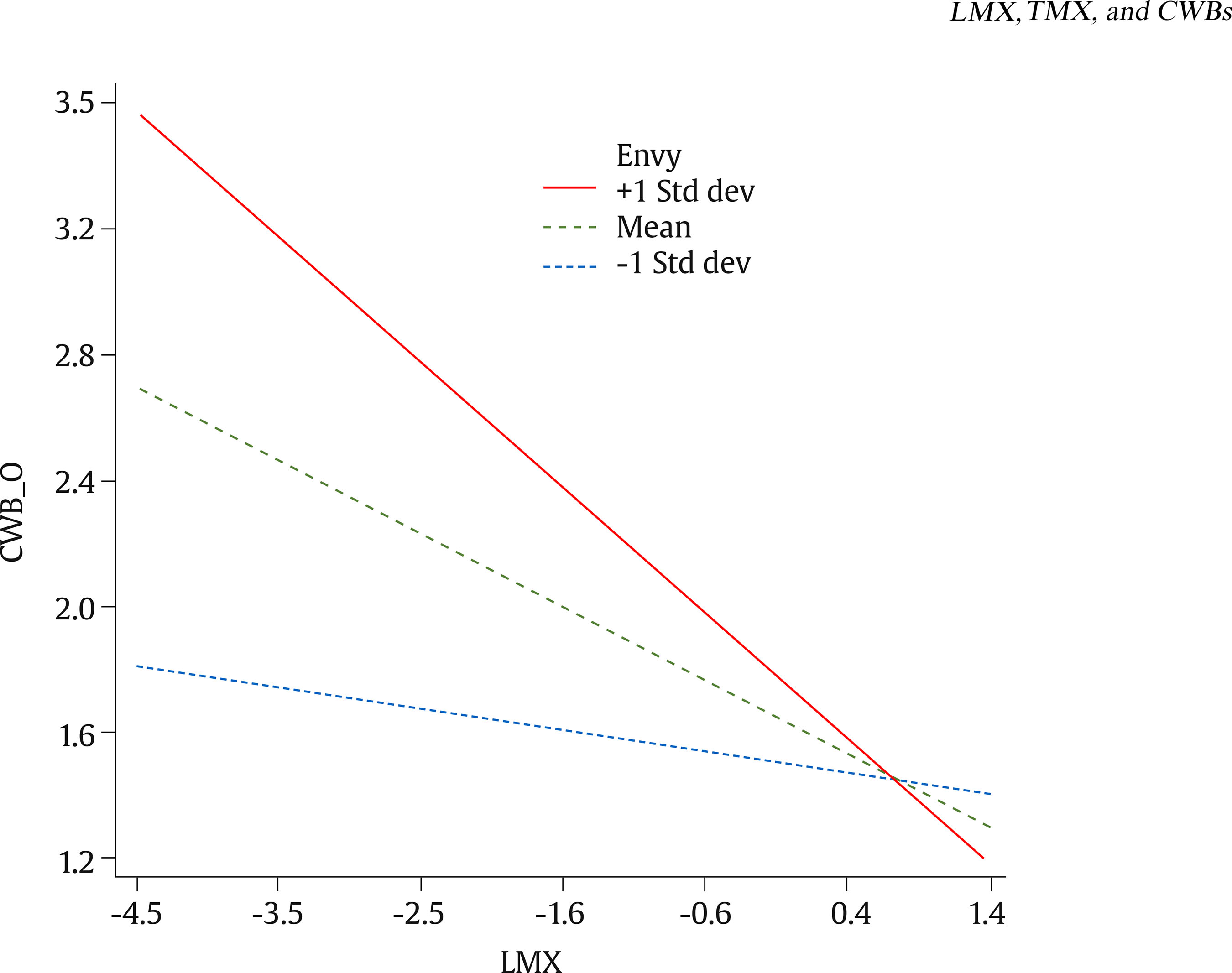 Figure 5 Interaction Effect (LMX × Envy) on CWB-I, USA Sample. 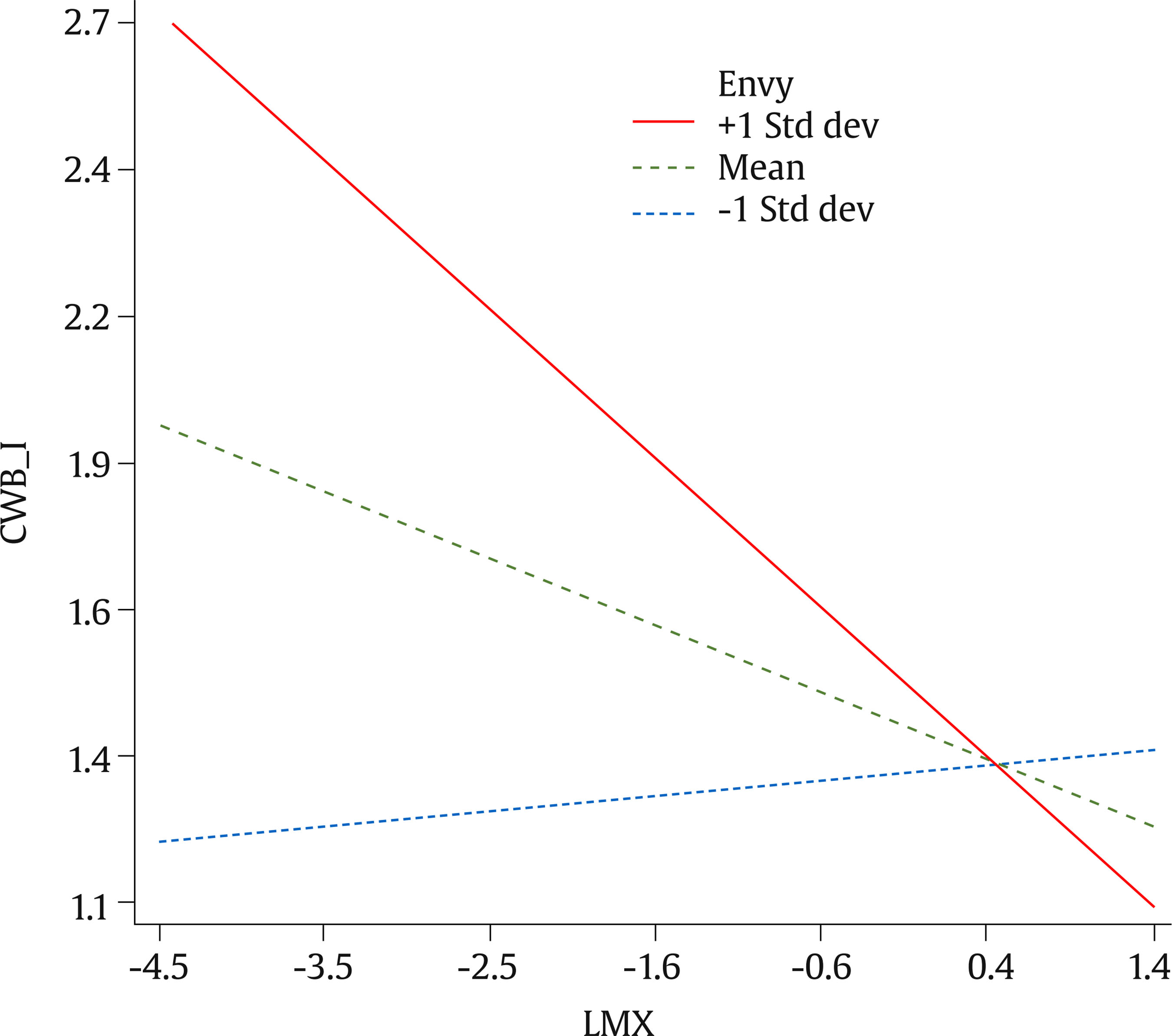 As can be seen in Table 4, all of the interaction effects were significant, and thus, envy moderates the relationships between LMX or TMX and CWB-O or CWB-I. However, H3.1-H4.2 were not supported, because the outcome is a direct opposite of the effect we hypothesized. In other words, we assumed envy would mitigate the effects of LMX/TMX on CWB-O/CWB-I, but instead it enhanced them; the more envy-prone the individual, the stronger the (negative) effect of LMX or TMX on CWB-O or CWB-I. We discuss these findings in the Discussion section. These findings are illustrated in Figures 4-7. Figure 6 Interaction Effect (TMX × Envy) on CWB-O, USA Sample. 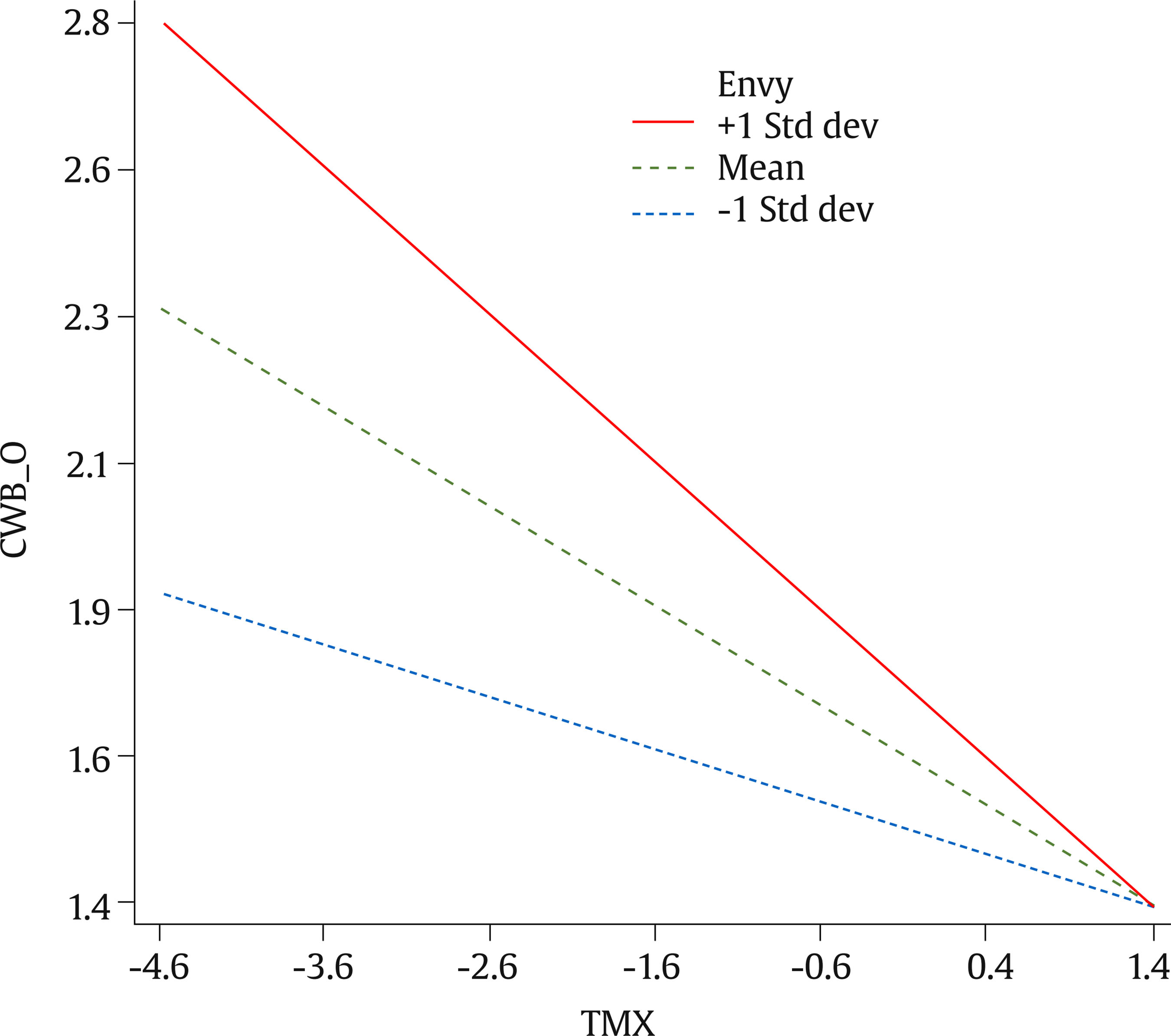 Figure 7 Interaction Effect (TMX × Envy) on CWB-I, USA Sample. 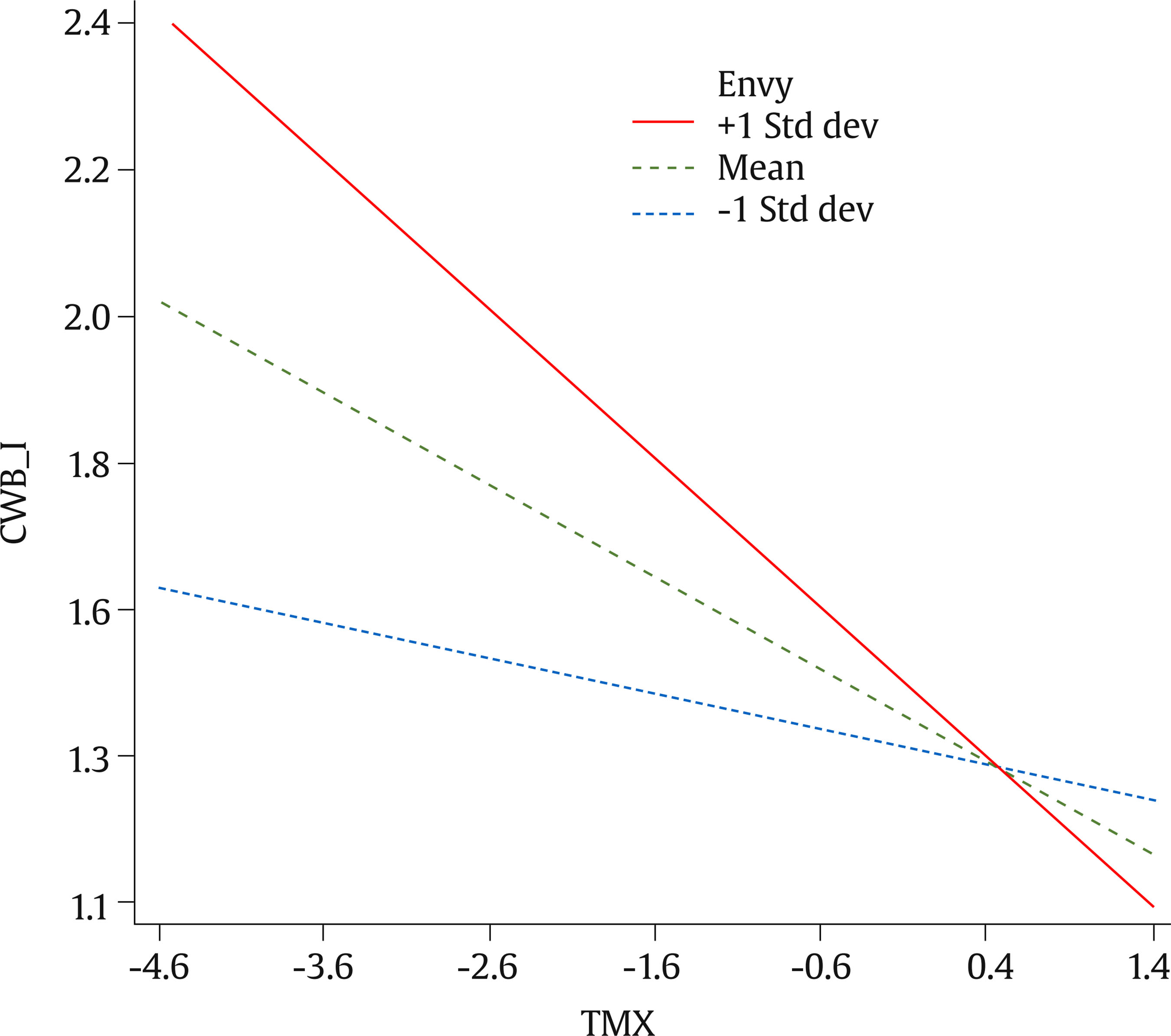 Figure 4 shows that as the Envy level increases, the negative effect that LMX has on CWB-O enhances (i.e., negatively enhanced). Figure 5 shows that as the Envy level increases, the negative effect that LMX has on CWB-I enhances (i.e., negatively enhanced). Of note, when Envy is at its lowest, the relationship between LMX and CWB-I is positive, yet weak. Figure 6 shows that as the Envy level increases, the negative effect that TMX has on CWB-O enhances (i.e., negatively enhanced). Figure 7 shows that as the Envy level increases, the negative effect that TMX has on CWB-I enhances (i.e., negatively enhanced). Additionally, as can be seen in Table 4, all of the interaction effects were significant, and thus, group size moderates the relationships between LMX or TMX and CWB-O or CWB-I. Hence, H5.1-H6.2 were supported. In other words, the bigger the size of the unit/team the employee works in, the weaker the (negative) effect of LMX or TMX on CWB-O or CWB-I. These findings are illustrated in Figures 8-11. Figure 8 Interaction Effect (LMX × Team Size) on CWB-O, USA Sample. 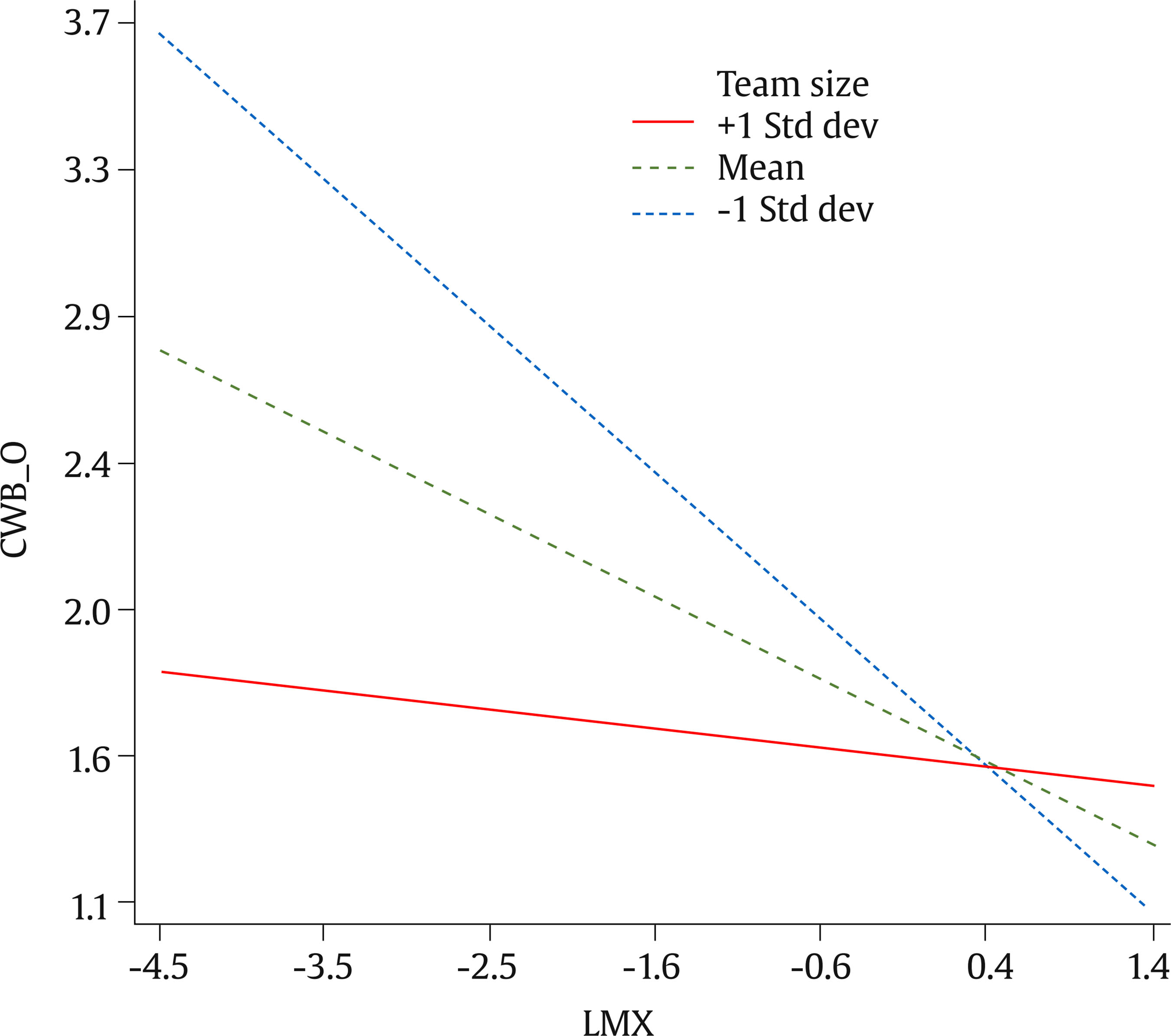 Figure 9 Interaction effect (LMX × Team Size) on CWB-I, USA Sample. 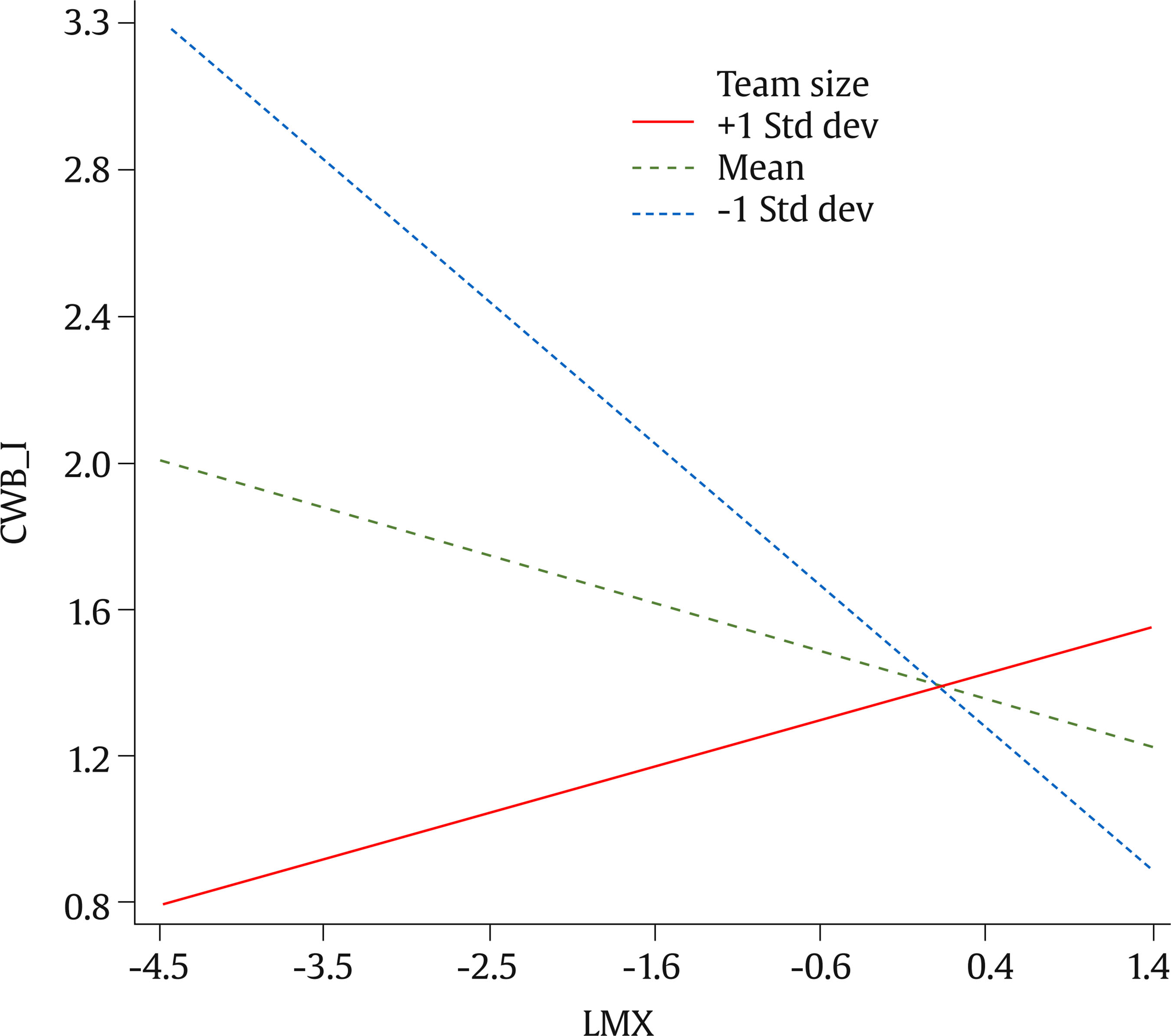 Figure 10 Interaction Effect (TMX × Team Size) on CWB-O, USA Sample.  Figure 11 Interaction Effect (TMX × Team Size) on CWB-I, USA Sample. 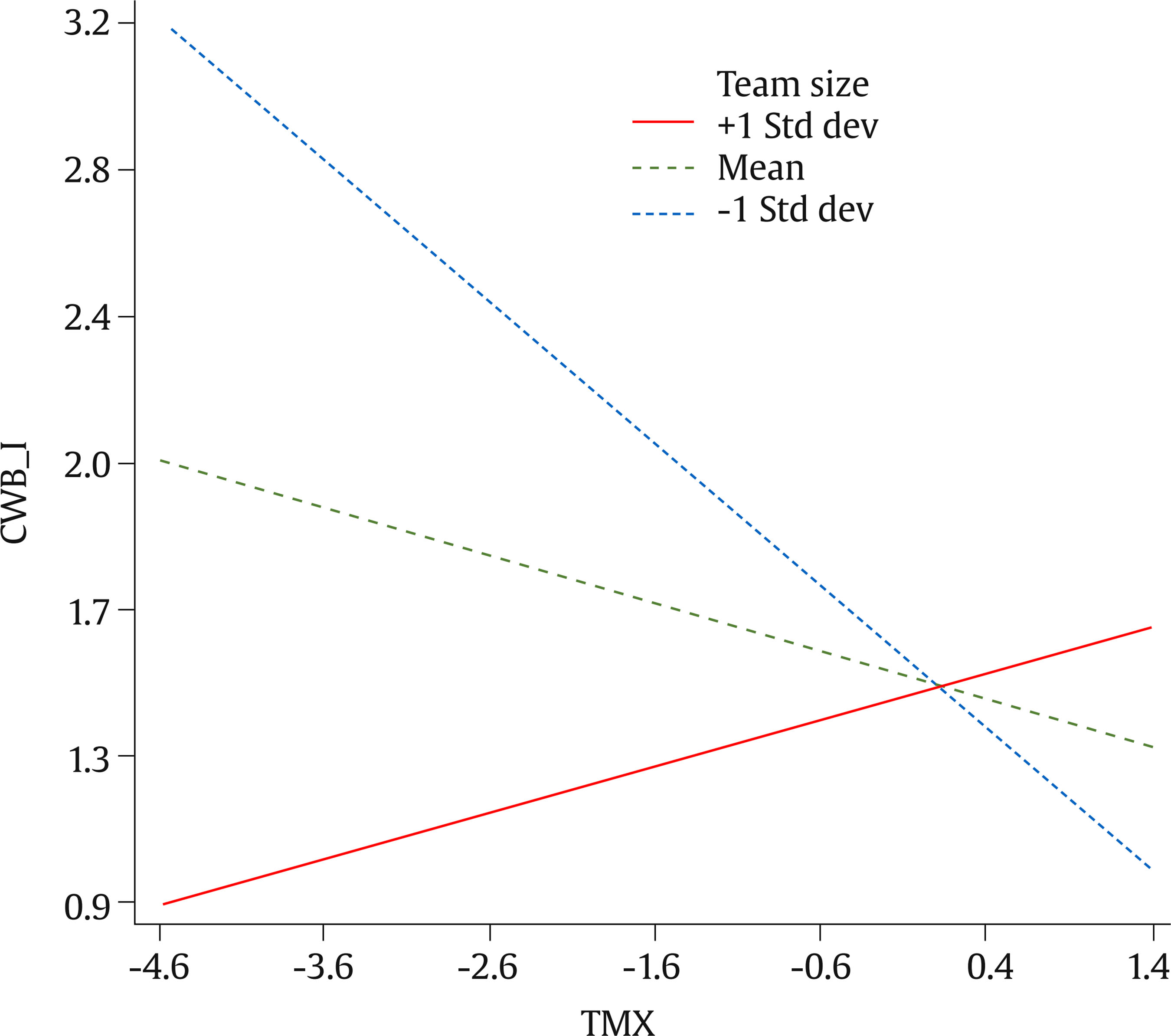 Figure 8 shows that as the group size increases, the negative effect that LMX has on CWB-O diminishes (i.e., positively enhanced). Figure 9 shows that as the group size increases, the negative effect that LMX has on CWB-I diminishes (i.e., positively enhanced). Of note, when group size is at its highest, the relationship between LMX and CWB-I is positive, and moderately-strong. Figure 10 shows that as the group size increases, the negative effect that TMX has on CWB-O diminishes (i.e., positively enhanced). Figure 11 shows that as the group size increases, the negative effect that TMX has on CWB-I diminishes (i.e., positively enhanced). Of note, when group size is at its highest, the relationship between TMX and CWB-I is positive, yet very weak. Discussion In the second (USA) sample, most of our hypotheses were corroborated. Both, good relations with the manager (i.e., LMX) and the team (i.e., TMX) led to decreased engagements in CWB-O and CWB-I. Furthermore, we found, as hypothesized, that the size of the team moderates said associations such that the larger the unit, the weaker the effects of LMX or TMX on CWB-O or CWB-I. This supports the notion that the effect and the prominence of both “herding mentality” (Braha, 2012; Toch, 1988) and “diffusion of responsibility” (Kassin, Fein, Markus, & Burke, 2013) we reviewed are more dominant in larger teams, as opposed to smaller ones. In addition, although not supported due to non-significance in Study 1, the moderation effects of envy on the negative effects of LMX or TMX on CWB-O or CWB-I were statistically significant, in this study. Envious individual(s) tends to feel inferior to the envied person(s) and would be more likely to actively try to assuage their feelings and change their subjective imposition (Heider, 1958). “Behaviorally, this means equalizing the envious person’s position with that of the envied person” (Cohen-Charash & Mueller, 2007, p. 666). One way of achieving this goal is to harm others (Heider, 1958; i.e., CWB-O and CWB-I) as firstly hypothesized. Table 5 depicts a summary of the hypotheses, from both Study 1 and Study 2. Table 5 Hypotheses Summary for Both Studies  Note. 1Study 1; 2Study 2 The present research aimed to show the effects of good relationships with the immediate manager (i.e., LMX) and/or the working group/team (i.e., TMX) on workplace misbehavior (i.e., CWB; both, towards the peers/colleagues [CWB-I] or towards the organization [CWB-O] themselves). In addition, we tested the conditional effects dispositional envy and group size had on said associations. To this end, we engendered two consequent studies (i.e., Study 1 and Study 2, in Israel and the USA, respectively) to test and retest our hypotheses (see also Figure 1). Our findings point that envy moderates the relationships between LMX or TMX and CWB-O or CBW-I, but only in the USA sample (Study 2), and no such effects were found in the Israeli one (Study 1). This supports the culturally-nested rationale we have given in the discussion section for Study 1; Israel is more collectivistic and has a lower power distance compared to the USA (see Hofstede, 2017), which may have led to different communication norms and characteristics. The direct, informal, and highly expressive communication (Hofstede, 2017) is so prominent and engrossed in the Israeli culture that the quality of the exchanges becomes of secondary importance. The lower power distance in Israel permits individuals to express themselves with minimal filters, regardless of the quality of the exchanges they have with other people. For example, the contents of a conversation at work may often include making fun of someone or joking about their personal life, which in many places would have been considered as a CWB-I, but in Israel it may be regarded as a “friendly gesture”. This rationale receives additional support from the differences between Israel and the USA in the link between LMX and CWB-I. While in Israel said association is positive (i.e., good relations with the direct manager increased the probability of engaging in CWB-I), in the USA these variables are negatively associated. This logic can also be applicated to the correlational differences of TMX and CWB (both dimensions), between Israel and the USA. In Israel, the social exchanges between team members are non-exclusive. For example, although an employee knows to which team he/she is formally positioned, he/she usually develops a wide range of social exchanges with other members of other teams. Therefore, his/her sense of belonging is not limited to the formal team positioning, to be expected by the informal communication culture in Israel. However, in the USA, the formalization is considerably higher and therefore a working team may be defined both, formally and socially. This eye-level, collective, direct, and informal communication, in Israel “steals the show” (see Shkoler et al., 2017) for the predictors (LMX and TMX) and the moderators (envy and group size) in regard to the interpersonal dimension of CWB. On the other hand, in the USA, power distance is considerably higher, and therefore the communication is more formal and reserved. In this sense, CWB-I behaviors are, mostly, a product of social exchanges, and are less affected by the style of communication. Another plausible explanation for the inconsistent moderation effects of dispositional envy (Israel vs. USA) is the role of organizational cultures encouraging envy as a motivational antecedent to work behaviors and performance (see Duffy, Shaw, & Schaubroeck, 2008). That is to say, such cultures make the conditions for envy (as a dispositional trait) to be manifested to a greater degree. Support for this logic can be derived from the Trait Activation Theory (Tett & Burnett, 2003), in which “trait activation is the process by which individuals express their traits when presented with trait-relevant situational cues” (p. 502). For example, greater time investment in work is encouraged by displaying employees who do so as “hero” role models (Shimazu, Kubota, & Bakker, 2015), and hence some organizations would praise these “heroes” in order to provoke and activate the envy disposition (see Duffy et al., 2008). As such, envy may manifest differently in various countries and cultures since their cues can activate it differently – depending on varying job tasks and organizational expectations (Tett & Burnett, 2003). Therefore, we may assume that the difference between cultures of Israeli and American organizations vary to a certain extent that the latter endorses envy as a motivational antecedent to work behaviors and performance (see Duffy et al., 2008). This notion is also supported by Study 2’s findings regarding envy as an enhancing moderator as hypothesized. It is important to note that, as mentioned, this is a possible explanation and should be further investigated in future research. Furthermore, group size in the USA case moderated all of the links suggested in the model (Figure 1), as hypothesized (see Study 2). However, in the Israeli case (Study 1) it emerged as a moderator only on the relationships between LMX- and TMX-organizational CWB, but not for interpersonal-CWB (see also, Table 5). In light of these findings, we propose that the cultural differences rationale plays, yet again, an important role in this web of associations. The informal communication in the Israeli culture (Hofstede, 2017) might mitigate or even cancel the impact the size of the group, such that Israeli workers may feel the same level of communication whether the work group is smaller or larger altogether (to a certain extent). In contrast, in the USA, the considerably higher formal and reserved communication may give the size of the group the power to influence it and the group’s intimacy. Respectively, small working groups may facilitate frequent and fluent communication between members and may enable them to better understand each other’s roles and skills (Katzenbach & Smith, 2015). Theoretical Implications Our paper shows the importance of conducting cross-cultural research. Specifically, it demonstrates that conceptual models may work differently in different cultures (see also Smith, 2002). This is backed up by exclusive journals which were founded on the fundamentals of cross-cultural differences (e.g., Journal of Cross-Cultural Psychology, Cross-Cultural Research, International Journal of Cross Cultural Management, etc.). We also demonstrated the importance of testing both individual differences and contextual variables (for further reading, see Judge & Zapata, 2015; Staw & Cohen-Charash, 2005) as each may give birth to interesting results, with special regard in cross-cultural cases. The conjunction of the two implications mentioned points at the cultural differences in attitudes and behaviors, which are of paramount importance when conducting researches, with special regard to drawing conclusions off them (see, for example Buzea, 2014; Smith, 2002). Practical Implications As our findings show, organizations should advocate maintaining good relationships between employees and their managers (as managers can provide employees with support and other work-relevant resources; Hobfoll, 1989; see also Zagenczyk, Purvis, Shoss, Scott, & Cruz, 2015), and also try to cultivate good relations between working groups’ members. All of which at the sole aim of reducing the probability that workers would engage in counterproductive work behaviors at the workplace. Organizations that encourage envy in order to motivate employees should carefully consider the repercussions of such a manipulation. In the USA, envy enables a stronger negative effect between LMX or TMX and CWB-O or CWB-I. Nevertheless, these findings were clearly not the same for Israeli sample. Ergo, engendering envy-based motivation may result in desirable/no/opposite outcomes of what the organization had wished to achieve in the first place. While envy-prone employees are more difficult to manipulate, the group size is easier to set. Organizations should encourage creating small, and therefore more intimate and communicative teams, in order to enjoy the positive effects of good relationships with managers and other team members. However as mentioned before, this is culture-dependent. Limitations Our research data was based on single-source scores, and as such may limit our understanding of the phenomena under investigation. Moreover, the items of the Dispositional Envy Scale (Smith et al., 1999) and the CWBs (Spector et al., 2006) are of a judgmental nature about the employee’s conduct at work. The questionnaire acts “as a critic”, thus making it hard for the examinee to report negative behaviors (including towards others). People usually find it hard to admit behaviors such as envy, theft, or disparagement of others, even to themselves or under promise of anonymity (see, for example, Shkoler & Tziner, 2017). Future Research We, thus, recommend (1) conducting more cross-cultural differences types of research in order to shed more light unto the construct validity of models tested in single countries, (2) testing our model in other countries to revalidate it (e.g., eastern societies), (3) using other-rater scores, not only self-report in data collection, and (4) making modifications to our model or test it with different moderators to portray a larger picture of the findings. For example, instead of envy and group size, perceived justice/fairness and industry type, etc. Acknowledgements We would like to express our profound gratitude to the reviewers for their insightful and helpful comments which considerably contributed to improving the quality of this paper. Cite this article as: Shkoler, O., Rabenu, E., Tabak, F., & Lebron, M. J. (2019). Leader- and team-member exchanges and their relationships with organizational and interpersonal counterproductive work behaviors: Moderation by envy and group size in Israel and USA. Journal of Work and Organizational Psychology, 35, 145-156.https://doi.org/10.5093/jwop2019a19 References |
Cite this article as: Shkoler, O. , Rabenu, E. , Tabak, F. , & Lebron, M. J. (2019). Leader- and Team-Member Exchanges and Their Relationships with Organizational and Interpersonal Counterproductive Work Behaviors: Moderation by Envy and Group Size in Israel and USA. Journal of Work and Organizational Psychology, 35, 145 - 156. https://doi.org/10.5093/jwop2019a19
Correspondence: or.shkoler@gmail.com (O. Shkoler).Copyright © 2026. Colegio Oficial de la Psicología de Madrid








 e-PUB
e-PUB CrossRef
CrossRef JATS
JATS






